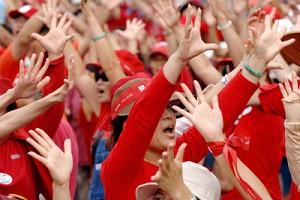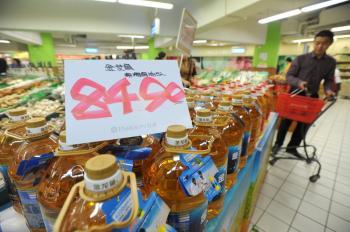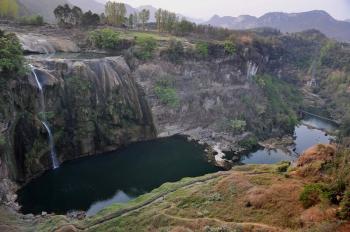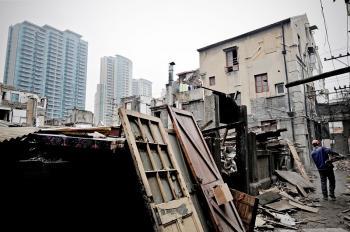In Taiwan, two colors normally dominate the political scene: blue and green, the respective colors of the two rivaling parties. Recently the color red has emerged onto the scene, worn by protesters who want current President Chen Shui-bian out of office. Many sources have looked at the funding received by protesters and various media in Taiwan, and suspect this new red color, now synonymous with the anti-president movement, is not simply a domestic homegrown persuasion—but rather that an external and indeed red entity, the Chinese Communist Party (CCP), is behind the red anti-president movement.
The blue parties, consisting of the Kuomintang (KMT) and People First Party (PFP) are pro-CCP, in favor of Taiwan’s reunification with China, and were in power before losing to President Chen in the 2000 and 2004 presidential elections. The green parties consist of the Democratic Progressive Party (DPP), which is President Chen’s party, and the Taiwan Solidarity Union (TSU). These are pro-independence and want Taiwan to be officially independent from China.
Recently President Chen was reported to be involved in a possible scandal that is currently under investigation. A former DPP chairman now leads the blue parties, in the name of anti-corruption, in efforts to push President Chen out of office.
Several sources, however, suspect the involvement of the Chinese Communist regime in the anti-president movement—including the channeling of financial support to the protesters and media in order to combat the pro-independence green parties. The anti-president movement in Taiwan started Sept. 9.
On Sept. 15, protesters wore red clothes and surrounded the Presidential Palace. Shi Cangshan, a China issues expert, said the CCP is the organizing force behind the red movement and is trying to create social unrest and conflict in Taiwan. Pro-CCP media in Taiwan called the parade “a long red dragon.”
Stability and Peace in Taiwan Threaten the CCP’s Political Power
Shi Cangshan said the CCP is using various different means to create turmoil in order to destabilize Taiwan and negate the values of the democratic system there. Democratic stability in Taiwan’s society is a great threat to the CCP’s power in China. Taiwan, with its traditional Chinese culture and western democratic values, makes clear in contrast the CCP’s anti-Chinese culture, anti-human rights, and anti-democracy ideology and practices. People in China can easily see through the CCP’s lies when they compare the two countries.
The CCP Buys Off and Infiltrates Overseas Media
It has long been known that the CCP buys off and infiltrates overseas Chinese media. The Jamestown Foundation, an independent U.S. non-profit organization, exposed the CCP’s attempts to control Chinese media in North America in its November 2001 report, “How China’s Government Is Attempting to Control Chinese Media in America.” The report states the CCP then controlled four Chinese media outlets in the U.S. through sponsorship or advertisements. According to Taiwan’s Southern News report, Taiwan’s intelligence department discovered at least 17 media outlets in Taiwan have been suspected of receiving large amounts of financial support from the CCP.
The CCP’s Media Falsely Reports Plots to Assassinate Taiwan’s Vice President
On three separate occasions, the CCP’s propagandist media have printed false reports to cause turmoil and incite people to panic. On Sept. 12, the CCP’s state-run and -controlled media, Xinhua Net and People’s Daily Online, quoted Hu Chung-Hsin, a political commentator from Taiwan, as saying President Chen Shui-Bian’s trusted followers were planning to assassinate Vice President Annette Lu. The reports also said Hu has good relations with the vice president. Hu also often poses as Lu’s representative. However, Lu made herself clear when she said, “What you [Hu] say represents you. Don’t jeopardize me.”
On Sept. 14, Xinhua Net posted an article saying pro-independent groups (President Chen’s supporting groups) accused Lu of planning to “usurp the throne.”
On Sept. 15, Xinhua Net again quoted Hu as having received information from National Security saying that President Chen had asked Chiou I-Ren, Secretary General of the National Security Council, to deal with the anti-president movement. The CCP media then said that Secretary General Chiou was planning to turn the anti-president movement into a situation of conflict and turmoil in order to assassinate Vice President Lu.
Major Taiwan Newspaper Reports on Possible National Strike
Mr. Shi Cangshan believes that the people behind the media that has been bought and infiltrated by the CCP are directing the anti-president movement. Another example is the China Times , a major Taiwan-based newspaper that printed reports of a possible national strike.
On Sept. 11, a China Times article reported the anti-president movement headquarters were planning to initiate a national strike starting as soon as mid-October. At the time, however, the headquarters had not been discussing the issue of when to initiate the strike.
The China Times also reported an unprecedented protest would take place before the protest even happened.
Mr. Shi said, “Without the CCP’s orders and intervention, a major Taiwan-based newspaper wouldn’t attempt to stir up a national strike in a critical time like this.”
Non-Stop Propaganda Promoting the Red Movement
The Apple Daily commentary describes how pro-CCP media in Taiwan are trying to promote the red movement. Every news broadcast stresses the anti-president red movement. Cable TV stations have even put up a small video frame of live reports about the anti-president movement during their advertising slots. They are using all their resources to gather support for the red movement.
According to the Apple Daily’s commentary, the news channels usually give 45 minutes of news every hour. Small frame live news reports during commercials are ordinarily used for very important news. The last time was for the Sept. 21, 1999 earthquake.
This time, almost all of the news channels have sponsored or participated in the anti-president movement. A statistic shows that in the afternoon news during the last several days, the broadcast rate of anti-president news reached 133 percent of regular news time (60 minutes news divided by 45 minutes news slot). A 16-page newspaper devoted six and a half pages to support Shi Ming-Teh, the leader of the anti-president movement.
The Apple Daily’s commentary also pointed out that the news channels that used to report on a variety of topics now only provide “red” news. Many news channels exclude news that are not related to the anti-president movement. Owners of the media, hosts of political shows, guests, and media workers have taken it one step further by providing ideas to promote the anti-president movement.
The commentary questioned whether most media in Taiwan had been bought off and become political tools.
The CCP Pulls the Strings Behind Big Business
Shi Cangshan said another characteristic of the red anti-president movement is that it is controlled by the CCP through consortiums. The CCP used internal conflicts within the DPP and instigated Shi Ming-Teh, a former high-ranking DPP official and former chairman, and his supporters to lead the opposing party and KMT’s supporters to start the protest.
For this reason, the media has described the movement as having a “green head, blue body.”
DPP legislator Lin Kuo-Ching told the media in August that Shi Ming-Teh went to Thailand in July 26 and met with Chen Yu-Hao, former chairman of the Tuntex Group. The next day Shi returned to Taiwan, and within 10 days started the anti-president movement. Chen Yu-Hao used to play an important role in Taiwan’s economy and has transferred all his assets in Taiwan to China; he now holds a PRC passport. Currently Chen Yu-Hao is one of the top 10 taxpayers in China. Shi Ming-Teh admitted having met with Chen in Thailand and claimed that Chen is a good friend of his.
According to Shi Cangshan, the CCP kills two birds with one stone by having a former chairman of the DPP start the anti-president movement. In this way, it weakens the DPP’s power and intensifies the conflict between the green and blue parties.




